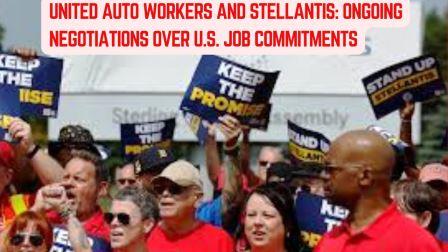The relationship between the United Auto Workers (UAW) union and Stellantis NV, one of the world’s largest car manufacturers, is currently facing challenges. The UAW has raised concerns over Stellantis’s commitment to investing in U.S. plants and creating jobs as outlined in their 2023 agreement. Stellantis, on the other hand, has stated that market conditions are influencing its business decisions. In this blog, we will take a closer look at the key points of the ongoing negotiations, the concerns on both sides, and what it could mean for the future of U.S. auto jobs.
The 2023 UAW-Stellantis Agreement: Key Commitments
In 2023, after a six-week strike, the UAW and Stellantis reached an agreement that included significant investments in U.S. operations. Stellantis committed to reopening the Belvidere Assembly plant by 2027, creating over 2,700 jobs. The company also pledged to build a parts distribution center and an electric vehicle battery plant in Illinois, along with producing gas and electric versions of the next-generation Dodge Durango starting in 2026.
These commitments were seen as a significant victory for U.S. auto workers, providing job security and opportunities in an evolving industry. However, recent reports suggest there may be delays in these plans, raising concerns among union members about the future of these projects.
UAW Concerns Over Delays and Job Security
The UAW has expressed concerns about Stellantis’s plans, particularly regarding delays in reopening the Belvidere Assembly plant and the potential movement of Dodge Durango production from Detroit to Canada. The union has filed grievances and unfair labor practice charges with the National Labor Relations Board, claiming Stellantis has not provided sufficient information about its production plans.
From the UAW’s perspective, these delays and possible shifts in production raise concerns about job security and the future of U.S. auto manufacturing. Many union members worry that if Stellantis moves production out of the U.S., it could result in job losses, contradicting the commitments made in the 2023 agreement.
Stellantis’s Response: Managing Market Conditions
Stellantis, in response, has emphasized that its decisions are driven by changing market conditions. The company has stated that reopening Belvidere and building new facilities depend on factors like consumer demand and plant performance. Stellantis has reiterated its commitment to investing in U.S. operations but notes that certain projects may be delayed to ensure sustainable and profitable production.
The company has also pointed out that it continues to monitor market trends and will communicate any updates to the UAW at the appropriate time. Stellantis maintains that it is not violating the terms of the contract but is adapting its plans to remain competitive in a dynamic industry.
Strike Authorization and Future Negotiations
In light of these concerns, the UAW has decided to hold strike authorization votes among its members. These votes will allow the union to strike if necessary to ensure Stellantis follows through on its commitments. While a strike is not yet confirmed, the possibility signals the seriousness of the situation.
Both the UAW and Stellantis have much at stake in these negotiations. For the union, ensuring that U.S. jobs are protected and investments are made as promised is a top priority. For Stellantis, balancing the need to fulfill contractual obligations while navigating market challenges is a delicate task. Both sides will need to find common ground to avoid further disruptions in production and ensure the future of U.S. auto jobs.
The Bigger Picture: U.S. Auto Jobs and Global Competition
The negotiations between the UAW and Stellantis highlight the broader challenges facing the U.S. auto industry. As automakers compete globally, decisions about where to produce vehicles are often influenced by cost considerations, including labor costs. Many UAW members fear that production could shift to countries with lower labor costs, such as Mexico, if U.S. plants are not reopened as promised.
At the same time, automakers like Stellantis must balance these concerns with the need to remain competitive in an evolving market, especially as they transition to electric vehicles. The outcome of these negotiations will likely set a precedent for future labor agreements and investment decisions in the auto industry.
Conclusion: A Complex and Ongoing Negotiation
The ongoing negotiations between the UAW and Stellantis are a reflection of the complexities that come with balancing job creation, investment, and global competition in the auto industry. The UAW is working to ensure that Stellantis upholds its commitments to U.S. workers, while Stellantis is navigating market pressures that may impact its ability to deliver on all its promises immediately.
As both parties continue to negotiate, the future of U.S. auto jobs remains uncertain. However, the discussions between the UAW and Stellantis are a critical reminder of the importance of open communication and collaboration in shaping the future of the automotive industry.
See Also- Tupperware Plans to File for Bankruptcy Amid Financial Struggles

Just wish to say your article is as surprising. The clearness in your post is just cool and i could assume you’re an expert on this subject. Fine with your permission allow me to grab your RSS feed to keep updated with forthcoming post. Thanks a million and please keep up the enjoyable work.
Hey! Do you know if they make any plugins to help
with SEO? I’m trying to get my website to rank for some targeted
keywords but I’m not seeing very good gains. If you know of any please
share. Kudos! I saw similar art here: Bij nl